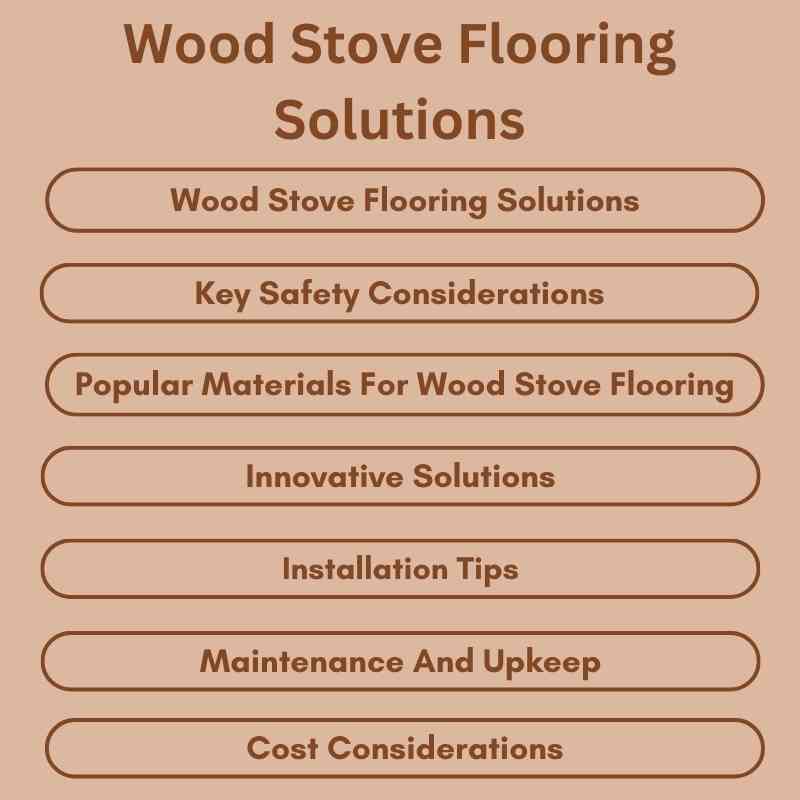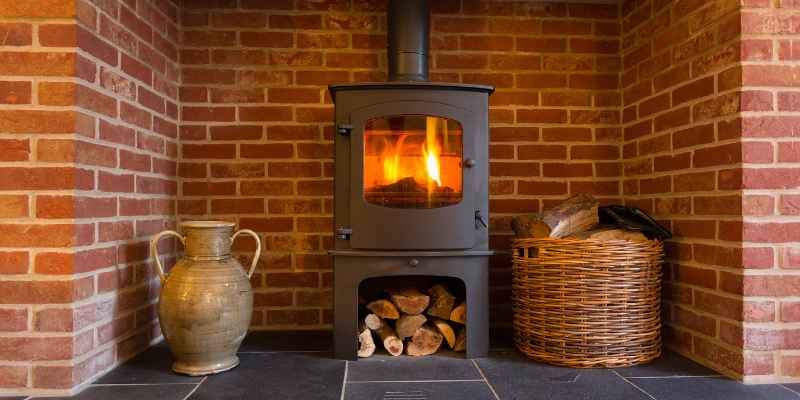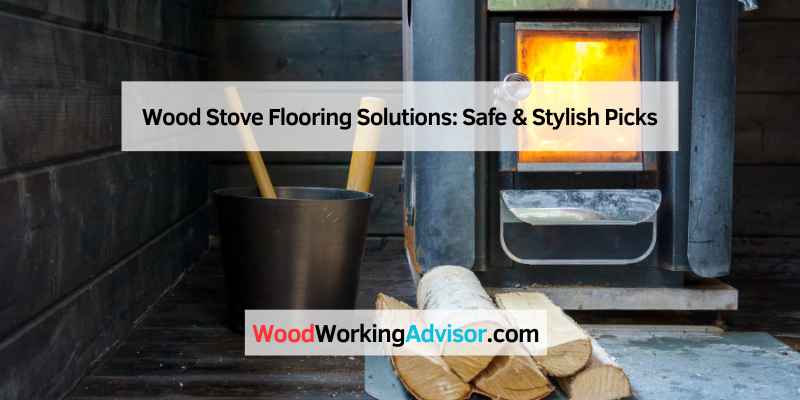Wood stove flooring must be non-combustible and durable. Materials like tile, concrete, or stone are ideal choices.
Choosing the right flooring for your wood stove area is crucial for safety and functionality. Proper flooring protects against heat damage and potential fire hazards. Non-combustible materials provide a safe barrier, while durable surfaces withstand wear and tear from logs and ash.
Consider the aesthetic appeal as well; your flooring should complement your home’s overall design. Installing the right flooring not only enhances safety but also improves the ambiance of your space. Whether you opt for elegant tiles or rustic stone, ensure your choice meets fire safety standards. Protect your home and enjoy the warmth of your wood stove with the right flooring solution.
Introduction To Wood Stove Flooring
Wood stove flooring plays a crucial role in home safety and aesthetics. It protects your home from heat damage. Choosing the right flooring ensures safety and enhances the beauty of your space.
The Need For Safe Flooring
Safety is a top priority when installing a wood stove. The right flooring prevents fire hazards and heat damage. Consider these factors:
- Material: Use non-combustible materials like tile or stone.
- Thickness: Ensure the flooring is thick enough to resist heat.
- Clearance: Maintain proper clearance around the stove.
Following safety guidelines protects your family and home. An appropriate floor also meets local building codes.
Aesthetic Appeal
Wood stove flooring adds charm to any room. It complements your stove and enhances your decor. Consider the following:
- Color: Choose colors that match your interior.
- Texture: Different textures can create a cozy feel.
- Patterns: Unique patterns can make your space stand out.
Use a mix of materials for a stunning look. Combine wood, stone, or tiles for a modern design. This approach creates a warm and inviting atmosphere.

Key Safety Considerations
Choosing the right flooring for a wood stove area is crucial. Proper flooring ensures safety and functionality. Below are essential safety considerations for wood stove flooring.
Heat Resistance
Heat resistance is vital for flooring near a wood stove. Floors must withstand high temperatures without damage.
- Materials: Use tiles, stone, or concrete.
- Class Rating: Look for materials rated for heat resistance.
- Clearance: Maintain a safe distance between the stove and flooring.
Durability
Durable flooring is essential for long-term safety. Wood stoves can cause wear over time.
- Hardwood: Choose hardwoods known for strength.
- Tile: Ceramic tiles are durable and resistant.
- Maintenance: Regular upkeep extends lifespan.
Ease Of Cleaning
Cleaning is crucial for safety and hygiene. Soot and ash can accumulate quickly.
- Non-porous Surfaces: Opt for surfaces that resist stains.
- Simple Cleaning: Choose materials that are easy to wipe.
- Frequency: Regular cleaning prevents buildup.
Popular Materials For Wood Stove Flooring
Choosing the right flooring for your wood stove area is crucial. The material must withstand heat and provide safety. Here are some popular options that combine style and durability.
Tile: Versatile And Durable
Tile is a top choice for wood stove flooring. It offers versatility in design and color. You can match any home decor with tile. Here are some benefits:
- Heat Resistance: Tile can handle high temperatures.
- Easy Maintenance: Simple to clean and maintain.
- Variety: Comes in many styles and sizes.
Consider ceramic or porcelain tiles for added strength. They resist scratches and stains well. Many homeowners prefer glazed tiles for a shiny finish.
Stone: Natural Beauty
Stone flooring adds a touch of natural beauty to any room. It creates an elegant look around your wood stove. Here are some popular stones:
| Stone Type | Features |
|---|---|
| Granite | Durable and heat-resistant. |
| Slate | Unique textures and colors. |
| Limestone | Soft and warm underfoot. |
Stone is strong and lasts a long time. It also helps to keep the area cool. Choose stone for a timeless look that complements your stove.
Brick: Rustic Charm
Brick flooring brings a rustic charm to your space. It creates a cozy atmosphere around your wood stove. Here are its key features:
- Durability: Brick is very strong and lasts long.
- Heat Retention: Holds warmth effectively.
- Easy Installation: Can be laid in various patterns.
Brick is perfect for a farmhouse or cottage style. It provides a non-slip surface too. This makes it a safe option for your home.
Innovative Solutions
Wood stove flooring has evolved. New materials make it safer and stylish. Explore two innovative solutions: cement slabs and glass. Both options enhance your space while providing safety.
Cement Slabs: Modern And Efficient
Cement slabs offer a robust and modern solution. They withstand heat and are easy to maintain.
- Durability: Cement is strong and long-lasting.
- Heat Resistance: It can handle high temperatures.
- Easy Maintenance: A simple wipe keeps it clean.
Cement slabs come in various designs. You can choose colors and textures to fit your style.
Glass: Sleek And Contemporary
Glass flooring adds a sleek touch. It creates a modern look in any room.
- Visual Appeal: Glass looks elegant and stylish.
- Heat Resistance: Special glass can resist heat.
- Easy Cleaning: Just use a glass cleaner for shine.
Glass flooring pairs well with different decor styles. It enhances the overall ambiance of your space.
Installation Tips
Installing wood stove flooring requires careful planning and execution. Proper installation ensures safety and durability. Follow these tips for a successful setup.
Preparation And Measurements
Accurate preparation is key for a smooth installation. Start by gathering your tools and materials:
- Measuring tape
- Level
- Wood stove flooring
- Safety goggles
- Utility knife
Measure the area where the stove will sit. Follow these steps:
- Determine the dimensions of the wood stove.
- Mark the area on the floor.
- Ensure the surface is level and clean.
Remember, the minimum clearance from the stove to combustible materials is essential. Check local codes for specific requirements.
Professional Vs. DIY Installation
Choosing between professional and DIY installation depends on your skills and comfort level.
| Aspect | Professional Installation | DIY Installation |
|---|---|---|
| Experience | Experts handle all tasks | Requires basic skills |
| Cost | Higher due to labor | Lower, save on labor |
| Time | Usually quicker | Varies by experience |
| Safety | Professionals ensure compliance | Risk if not careful |
Evaluate your skills before deciding. Hiring a professional can save time and ensure safety.
Maintenance And Upkeep
Maintaining your wood stove flooring is essential for its longevity. Regular care keeps it looking great and functioning well. Here are key tips for routine cleaning and handling wear and tear.
Routine Cleaning Tips
Keeping your wood stove flooring clean prevents damage and enhances appearance. Follow these simple steps:
- Dust Regularly: Use a soft broom or a vacuum cleaner.
- Wipe Spills: Clean up any spills immediately.
- Use a Damp Cloth: For deeper cleaning, use a damp cloth.
- Avoid Harsh Chemicals: Stick to wood-friendly cleaners.
- Check for Debris: Remove any dirt or debris weekly.
Consider a monthly deep clean. Use a wood cleaner to maintain shine.
Dealing With Wear And Tear
Wear and tear can happen over time. Early intervention is crucial. Here’s how to manage it:
| Issue | Solution |
|---|---|
| Scratches | Use wood filler to repair. |
| Dents | Steam and buff out gently. |
| Loose Boards | Re-secure with wood glue. |
| Water Damage | Dry immediately and sand down. |
Check your flooring regularly. Early detection prevents bigger issues. Maintain your wood stove flooring for lasting beauty and functionality.
Cost Considerations
Understanding the costs associated with wood stove flooring is essential. Different materials and installation methods affect overall expenses. This section explores budgeting and the long-term value of your flooring choices.
Budgeting For Flooring
Start by setting a clear budget for your wood stove flooring. Consider these factors:
- Material Costs: Options include tile, hardwood, and laminate.
- Installation Fees: Professional installation may add to your costs.
- Maintenance: Some materials require more upkeep than others.
Here’s a quick table showing average costs:
| Material | Cost Per Square Foot |
|---|---|
| Tile | $5 – $15 |
| Hardwood | $8 – $20 |
| Laminate | $1 – $5 |
Long-term Investment Value
Choosing the right flooring is a long-term investment. Consider these benefits:
- Durability: High-quality materials last longer.
- Resale Value: Good flooring increases home value.
- Energy Efficiency: Some options retain heat better.
Investing in quality flooring pays off over time. Consider both immediate and future costs. Your wood stove flooring should enhance your home’s value.
Real-life Examples
Seeing how wood stove flooring transforms spaces can inspire you. Real-life examples highlight the beauty and functionality of this flooring choice.
Case Studies
Here are some interesting case studies showing the impact of wood stove flooring:
| Homeowner | Location | Before Flooring | After Flooring |
|---|---|---|---|
| John & Sarah | Vermont | Carpet | Warm oak planks |
| Emma | Colorado | Tile | Rustic pine boards |
| Tom | New York | Concrete | Dark walnut finish |
Before And After Transformations
Transformations can be striking. Here are some notable changes:
- John & Sarah:
They replaced worn-out carpet with oak planks. The warmth and elegance enhanced their living space.
- Emma:
Old tile floors got replaced by rustic pine boards. This change added charm and comfort to her kitchen.
- Tom:
He swapped cold concrete for dark walnut. The new floor radiates luxury and coziness.

Frequently Asked Questions
What Type Of Flooring Is Best For A Wood Stove?
The best flooring for a wood stove is non-combustible material. Options include tile, stone, or concrete. These materials can withstand high temperatures and prevent fire hazards. Additionally, they are easy to clean and maintain. Ensure that the flooring extends beyond the stove for added safety.
How Do I Protect My Floor From A Wood Stove?
To protect your floor from a wood stove, use a heat-resistant mat or pad. This will shield the flooring from heat and embers. Additionally, consider installing a non-combustible hearth extension. Regularly inspect the area for any signs of wear or damage to ensure ongoing safety.
Can I Use Carpet Under A Wood Stove?
Using carpet under a wood stove is not recommended. Carpeting is highly flammable and poses a significant fire risk. Instead, opt for non-combustible materials like tile or stone. These options provide better protection and are safer for your home environment.
How Far Should A Wood Stove Be From The Floor?
A wood stove should be installed at least 18 inches off the floor. This distance helps prevent heat buildup and protects flooring materials. Always consult local building codes for specific requirements. Proper installation also ensures optimal performance and safety of the wood stove.
Conclusion
Choosing the right flooring for your wood stove area is essential for safety and aesthetics. Consider materials that can withstand heat and provide durability. Proper installation ensures longevity and enhances your home’s charm. Invest time in selecting the perfect flooring to enjoy a cozy and stylish living space for years to come.

